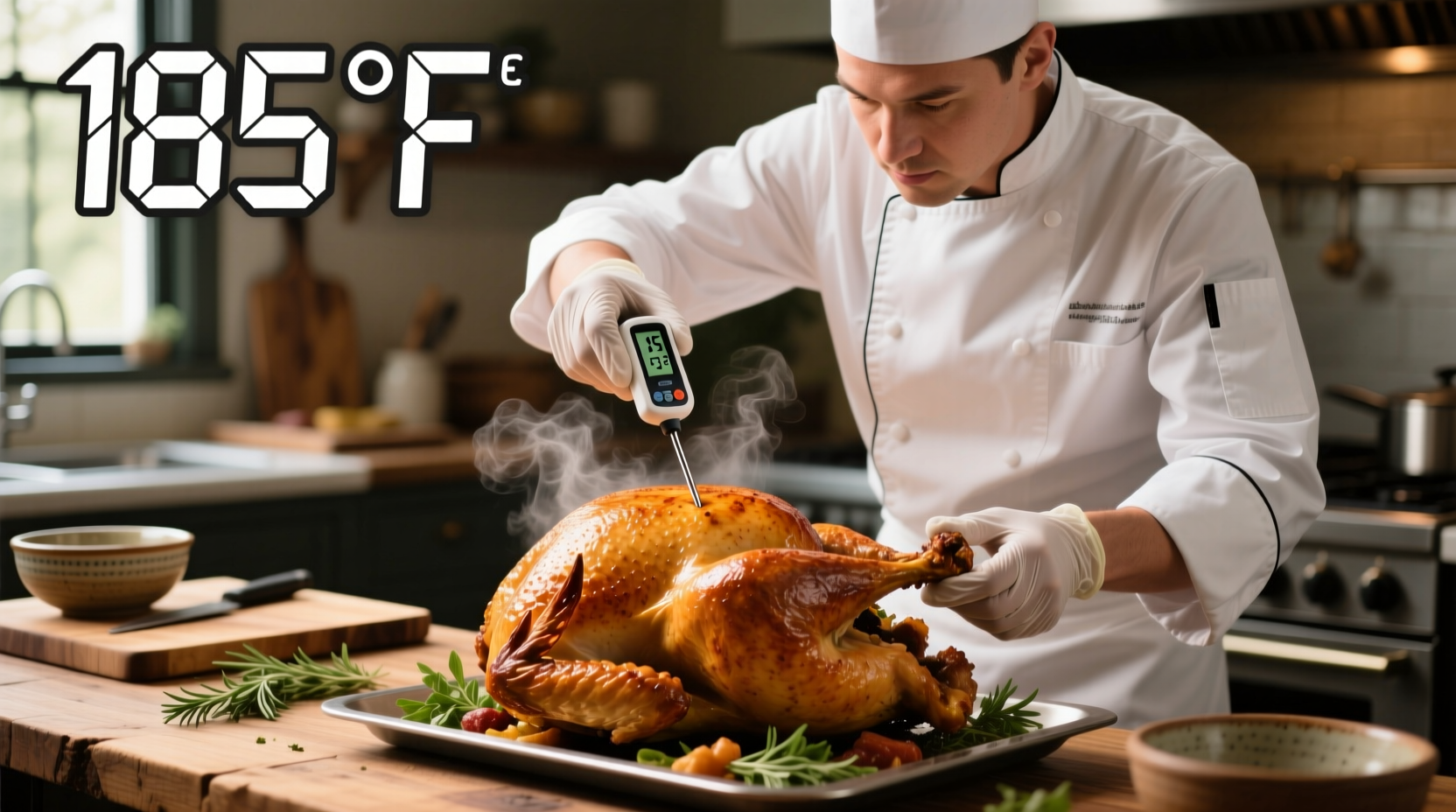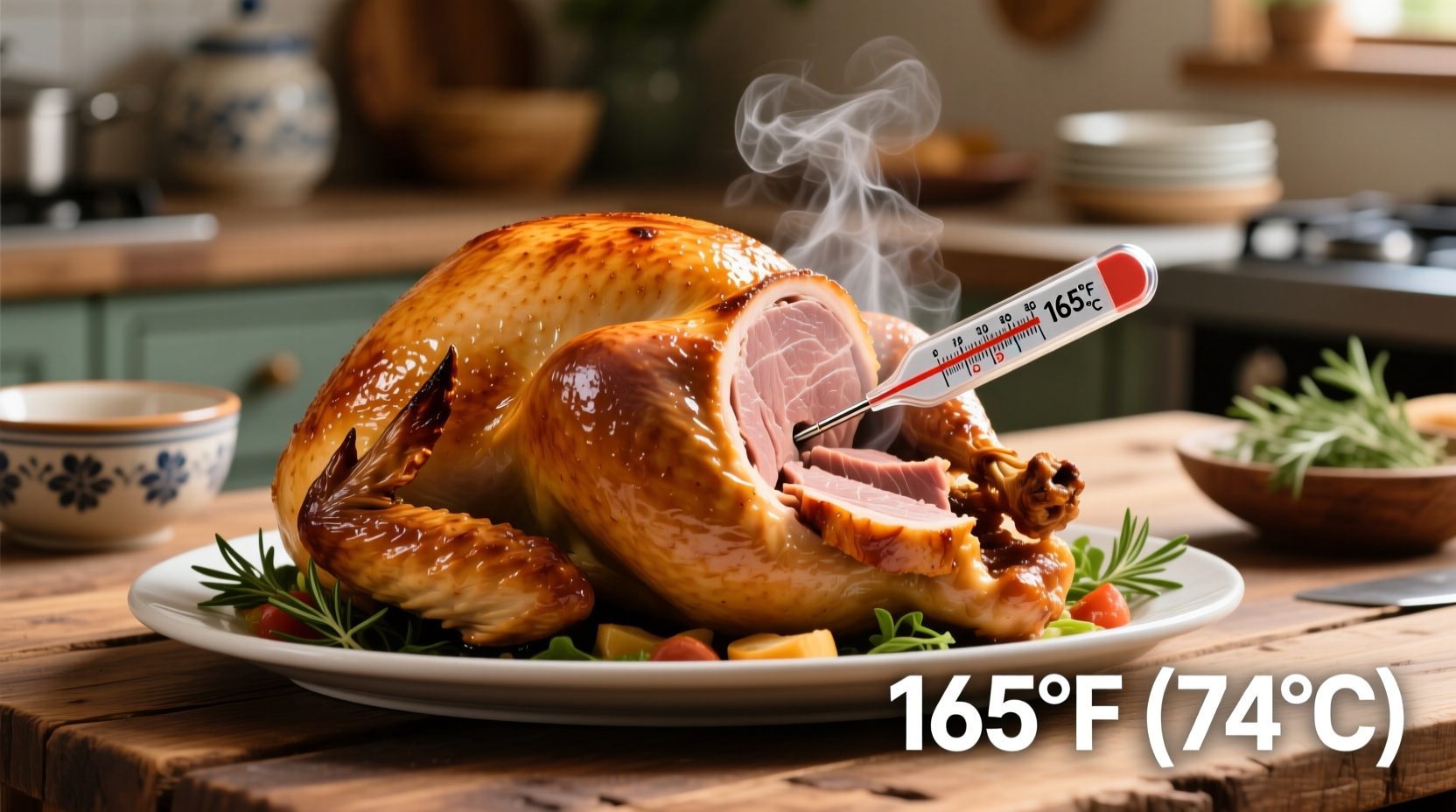The safe internal temperature for cooked turkey is 165°F (73.9°C) as measured with a food thermometer in the thickest part of the breast, thigh, and wing joint. This temperature destroys harmful bacteria like Salmonella and Campylobacter, ensuring your turkey is safe to eat while maintaining optimal moisture and texture.
Nothing ruins a holiday gathering faster than foodborne illness. When you're preparing turkey—whether it's for Thanksgiving, Christmas, or a special Sunday dinner—you need absolute certainty about cooking temperatures. As a chef who's worked in both professional kitchens and taught countless home cooks, I've seen too many people guess their way through turkey preparation, risking illness for the sake of convenience. Let's get this right, once and for all.
Why 165°F Is Non-Negotiable for Turkey Safety
Food safety isn't a matter of opinion—it's science. The USDA Food Safety and Inspection Service (FSIS) established 165°F as the minimum safe temperature for poultry based on extensive research into pathogen destruction. At this temperature, dangerous bacteria like Salmonella and Campylobacter that commonly contaminate raw turkey are eliminated instantly.
"Many home cooks rely on visual cues like clear juices or meat color to determine doneness, but these methods are dangerously unreliable," explains Dr. Mindy Brashears, former USDA Deputy Under Secretary for Food Safety. "Only a properly calibrated food thermometer provides the accuracy needed to ensure safety."
| Poultry Type | Minimum Safe Internal Temperature | Rest Time After Removal From Heat |
|---|---|---|
| Whole Turkey | 165°F (73.9°C) | 3 minutes |
| Turkey Breast | 165°F (73.9°C) | 3 minutes |
| Turkey Thighs/Drumsticks | 170-175°F (76.7-79.4°C) | 3 minutes |
| Ground Turkey | 160°F (71.1°C) | None |
This temperature standard applies regardless of cooking method—roasting, grilling, smoking, or deep-frying. The USDA updated its guidelines in 2011 to clarify that 165°F is the only safe temperature for poultry, eliminating previous recommendations about lower temperatures with extended rest times.
Where and How to Check Your Turkey's Temperature
Proper thermometer placement makes all the difference. Many cooks make the critical error of checking only one spot, potentially missing undercooked areas.
Follow these steps for accurate temperature readings:
- Insert your thermometer into the thickest part of the breast, avoiding bone
- Check the innermost part of the thigh (where the thigh meets the body)
- Verify the wing joint temperature
- For stuffed turkeys, check the center of the stuffing separately
"I recommend using an instant-read thermometer for spot checks and a leave-in probe thermometer for continuous monitoring," says food scientist Dr. Antonio Rodriguez. "Digital thermometers are far more accurate than dial models, especially for critical safety thresholds."

Common Temperature Mistakes That Risk Food Safety
Even experienced cooks fall into these dangerous traps:
- Checking too early - Opening the oven repeatedly drops temperature and extends cooking time
- Not calibrating thermometers - Most thermometers drift over time; ice water (32°F) and boiling water (212°F) tests verify accuracy
- Misreading the thermometer - Digital displays can be misinterpreted; analog needles require proper eye alignment
- Ignoring carryover cooking - Turkey continues cooking 5-10°F after removal from heat
- Trusting unreliable indicators - Clear juices, meat color, and pop-up timers don't guarantee safety
Special Considerations for Different Cooking Methods
While the 165°F standard remains constant, different cooking techniques require specific temperature management:
Smoked Turkey: Low-and-slow smoking requires careful monitoring as the extended cooking time can lead to false confidence about doneness. The USDA Meat and Poultry Hotline emphasizes that "smoking does not eliminate the need for thermometer verification."
Deep-Fried Turkey: The rapid cooking process makes precise temperature monitoring critical. Insert your thermometer during the final 10 minutes of cooking to avoid oil splatter.
Sous Vide Turkey: This method allows cooking at precise lower temperatures for extended periods, but requires strict adherence to time-temperature tables from the FDA Food Code to ensure pathogen destruction.
What Happens If You Cook Turkey Below 165°F?
The risk isn't theoretical. According to CDC data, Salmonella causes approximately 1.35 million infections, 26,500 hospitalizations, and 420 deaths in the United States every year, with poultry as a primary source.
"Some chefs advocate for lower temperatures like 150°F with extended rest times, but this approach carries significant risk for home cooks," warns Dr. Elisabeth Hagen, former Under Secretary for Food Safety at USDA. "The margin for error is too small when dealing with pathogens that can make your entire family seriously ill."
Commercial kitchens may follow different guidelines under HACCP plans, but home cooks should always adhere to the 165°F standard for complete safety.
Practical Temperature Verification Checklist
Follow this simple protocol for foolproof turkey cooking:
- Calibrate your thermometer before starting
- Insert thermometer in multiple locations as turkey approaches target temperature
- Verify all readings reach 165°F before removing from heat
- Allow proper rest time (about 20 minutes for whole turkey)
- Refrigerate leftovers within 2 hours (1 hour if room temperature exceeds 90°F)
Remember that food safety isn't just about the cooking temperature—it's about the entire process from preparation to storage. The USDA FoodKeeper app provides comprehensive guidance on safe storage times for cooked turkey and other foods.











 浙公网安备
33010002000092号
浙公网安备
33010002000092号 浙B2-20120091-4
浙B2-20120091-4